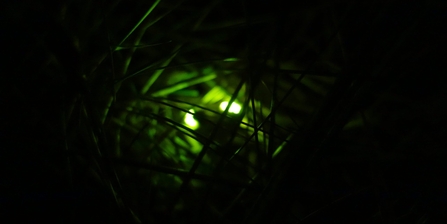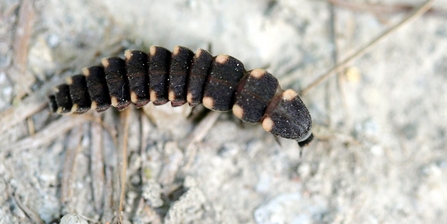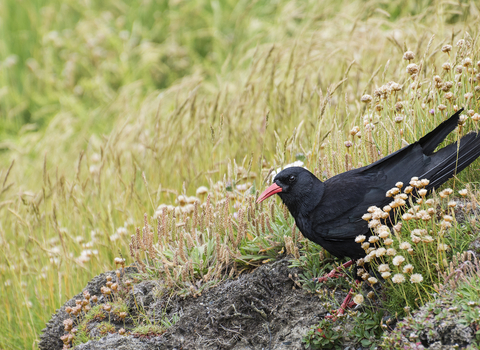
Two glow worms shine amongst the marram grass
I arrived at the home of the Rumble family just before 10pm, where I was welcomed in for a cup of tea and a chat, while we waited for it to get a bit darker. The Rumbles have been managing Gwithian Sands Chalets since 2002, living on-site in their eco-build home in the dunes. Living in such an amazing location has built a connection between the people and the place, as they clearly care very much about their site and its surrounding wildlife. For example, Steve is a member of The Towans Partnership, which helps to promote communication between the various land owners and site users in the area. One of the ways Carol has got to know and love the dunes is to go out for a walks late in the evenings, to look for the amazing glow worms!
I’d done a bit of homework prior to my visit, and it turns out that the Glow-worm is not actually a worm, but a beetle (Lampyris noctiluca). Males look like typical beetles, but the adult females look different – they have no wings and look quite similar to the younger larvae. It’s these females who are the stars of the show, as they are famous for emitting a greeny coloured light from their bottoms at night! The tiny ‘lanterns’ in their rear ends are incredibly efficient, with 98% of the energy going into the reaction emitted as a ‘cold’ light. The females climb up plant stems in the summer and glow in order to attract males, who have large, photosensitive eyes - perfect for scanning vegetation at night.
The rest of the year these creatures will exist as eggs or as larvae. Larvae are the teenagers of the insect world – they just eat lots and grow bigger! Glow worm larvae, however, are not known for eating whole packets of biscuits at a time; instead they are predators, feeding on slugs and snails. They kill their prey by delivering a series of toxic bites, injecting digestive proteins that paralyse and eventually dissolve the soft body of the slug or snail – yuk! In the day time, you might see a glow-worm larva waiting for its prey to die, riding on the snail's shell to keep away from the sticky mucus it produces.
Anyway, back to the sand dunes. After a cup of tea and a chat, Carol, Steve, their daughter Mia and I went off to look for glow worms. It didn’t take long – one was glowing away right under their car! As being hidden under a car is not the best way for a female to attract a male’s attention, the car was moved out of her way, before we carried on our hunt. As we moved further into the dunes, we saw another, then another, then two more – all shining brightly amongst the marram grass. Before too long we’d seen over 30 and Carol and co. were as excited as I was, as this was the most they had ever counted!

Glow worm larva (Lampyris noctiluca), Image Jim Higham
By the end of our walk we had counted 75 animals, which we were all delighted with. Is it a good year for glow worms? Has lockdown affected their numbers in any way? Are glow worm numbers increasing or decreasing? It’s so hard to know the answers to questions like this, which is why long-term monitoring of species is so important. As part of Dynamic Dunescapes, we want to support local people to record what’s living in their dunes, so we can make well-informed decisions on how to manage these amazing habitats for the future.
There was something quite magical about seeing all these tiny green lights glowing in the dunes - I’m definitely going to go looking for them again! If you want to see this amazing display, try hunting for glow worms shining brightly at night in grasslands between June and August. If you see them, I reckon you’ll feel a warm glow inside!
Contact
Contact Andy Nelson, People Engagement Officer, via email to find out more about events and opportunities to get involved. You can also like the Dynamic Dunescapes Cornwall Facebook page to keep up to date on the project.





